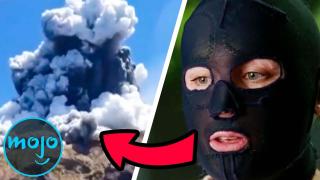Top 10 Scariest Places on Earth You Should Never Visit Alone

#10: Sedlec Ossuary
Sedlec, Czech Republic On the outside, the Czech Republic’s Cemetery of All Saints seems like any other quaint, small town cemetery. But underneath, it looks like a serial killer’s lair. The Sedlec Ossuary is located below the Cemetery of All Saints in Sedlec, Czech Republic, and it contains the skeletons of up to 70,000 people. The bones are artistically arranged to form various “attractions” and furnishings, including a chandelier composed of every bone in the human body. The area has been a desirable burial site since the 13th century, and it contains many victims of the Black Death and Hussite Wars. The ossuary itself was built around 1400 to house the bones of those buried on the property in mass graves.
#9: Chillingham Castle
Northumberland, England The suitably named Chillingham Castle is certainly chilling all right. Located in northern Northumberland, this Medieval castle dates back to the 12th century, when it served as a monastery. It was even visited by King Edward I of England in the late 13th century, while he was traveling to fight William Wallace. It is said to be the most haunted castle in all of Britain, known primarily for its resident “blue boy.” Guests would supposedly hear a loud wailing noise and witness a blue halo floating above their beds. However, the hauntings have reportedly stopped after renovation work uncovered the bones of a young boy buried within the walls.
#8: Snake Island
Top 10 Real Life Snake Attack Stories
Itanhaém, Brazil You can probably guess what occupies Snake Island. Ilha da Queimada Grande is a small, 106-acre island located off the southeastern corner of Brazil. It is inhabited by untold numbers of snakes, who became trapped on the island once rising sea levels cut it off from the mainland. It remains the only place on Earth to host the endangered golden lancehead, a highly venomous pit viper that devours birds. It is estimated that up to 4,000 golden lanceheads reside on the island. Snake Island cannot be visited by citizens, both to protect the endangered snakes from prying eyes and the humans from becoming snake victims. The only people allowed there are select researchers and members of the Brazilian Navy.
#7: Yungas Road
Yungas, Bolivia Health and safety? Pshaw. Yungas Road is located in Bolivia, linking the city of La Paz to the greater Yungas region. Chillingly nicknamed the Road of Death, Yungas Road was famous for its complete lack of safety precautions. The road itself is very thin, which doesn’t allow for many mistakes. There are no guardrails, the slopes are steep, and the area is regularly hit by heavy rain and fog cover, making travel an extremely dangerous expedition. A new road has been built for driving, but Yungas remains a popular tourist destination owing to its stellar mountain biking - even though 18 cyclists have died on the route since 1998.
#6: Catacombe dei Cappuccini
Palermo, Italy Forget the Paris Catacombs. These catacombs located in Palermo, Sicily originated in the 16th century when monks excavated crypts below the overpopulated Capuchin monastery. It soon became a status symbol to be buried within the Capuchin catacombs, and it was maintained through donations paid by the rich relatives of the entombed. It’s estimated that the catacombs contain 8,000 corpses and 1,252 mummies, all of which are visible to the public, and even set in various poses. Each of the bodies are categorized into different “sections” of the catacombs, including Men, Women, and Children. The catacombs are also famous for hosting Rosalia Lombardo, a one-year-old child whose preserved body remains in exceptional condition.
#5: Beelitz-Heilstätten
Beelitz, Germany Abandoned and deteriorating hospitals are inherently creepy places - never mind one with such a rich and disturbing history. Located in Beelitz, Germany this large hospital complex encompasses around 60 different buildings. The hospital was originally used as a tuberculosis sanatorium before it was converted to a war hospital. During World War I it housed injured soldiers of the Imperial German Army, including Adolf Hitler after he was wounded at the Battle of the Somme. It was later occupied by the Red Army throughout World War II and remained as a Soviet military hospital well into the ‘90s. Most of the complex is now a derelict ghost town, having been completely abandoned in 1994.
#4: Centralia
Columbia County, Pennsylvania There’s an area of Pennsylvania that has essentially been on fire since 1962. In the early ‘60s, Centralia hosted roughly 1,500 residents, but the area suffered a horrific coal mine fire that is estimated to keep burning for another 250 years. The major detrimental effects weren’t really known until 1981, when a sinkhole randomly opened and nearly killed a 12-year-old boy. The government bought out most of the residents and had them relocated, leaving just 63 people by 1990. Today, the town hosts under a dozen citizens, and various signs are littered throughout the area warning of sudden ground collapse and fatal levels of carbon monoxide. A “graffiti highway” that became a destination spot in the area has been paved over as of 2020.
#3: Island of the Dolls
The Shocking True Story Of The Whakaari / White Island Eruption
Mexico City, Mexico Turns out there are many areas throughout the world populated by dolls. There’s a village in Japan called Nagoro which has become a famous tourist attraction due to its countless lifesize dolls. But perhaps the freakiest of all is Mexico City’s La Isla de las Muñecas, which is located in the canals of Xochimilco. The island contains hundreds of dolls, most of which are hung from the trees. Legend states that the spirit of a young girl haunted the island, forcing its owner to hang dolls from the trees to appease her ghost. The owner passed away in 2001 and the island became a popular tourist destination, even though some locals refuse to go there owing to superstition.
#2: Pripyat
Pripyat, Ukraine Now here’s a ghost town. Pripyat is what was called a nuclear city, housing the employees of the nearby Chernobyl Nuclear Power Plant. It was the home of thousands of citizens until the power plant famously exploded on the morning of April 26, 1986, spreading an unbelievable amount of radiation into the area, including Pripyat. The town was not immediately evacuated, despite dozens of people falling ill and showing signs of acute radiation sickness. The evacuation was finally ordered 36 hours after the blast, and the city remains abandoned for long-term residents, although governmental authorities still did work in the area and there is now limited tourism. It is now part of the wider Chernobyl Exclusion Zone. Before we unveil our top pick, here are a few honorable mentions. Christ of the Abyss Liguria, Italy The Stanley Hotel Estes Park, Colorado The Great Blue Hole Belize Caminito del Rey Málaga, Spain
#1: The Door to Hell
Top 20 Scariest Places on Earth You Should Never Visit Alone
Derweze, Turkmenistan Turns out, the door to Hell exists, and it’s located in Turkmenistan. The village of Derweze is home to the Darvaza gas crater, which was unintentionally created in 1971 while Soviet engineers were drilling for oil. Fearing the release of dangerous methane gas, the engineers decided to light the crater on fire in the hopes of burning off the methane. The crater has continued to burn throughout the decades and shows no signs of slowing down. So now, in the middle of the Karakum Desert, there’s a 100-feet deep crater that is persistently on fire. Naturally, the site is off limits to both tourists and almost all documentarians. You wouldn’t want to get pulled into Hell, would you?




